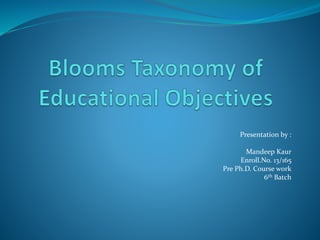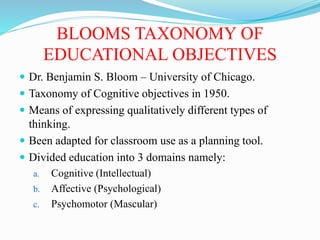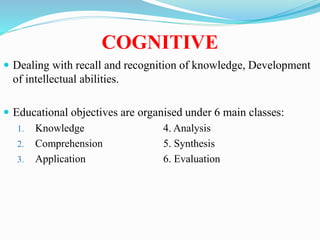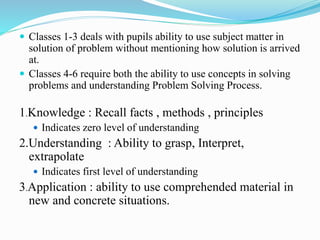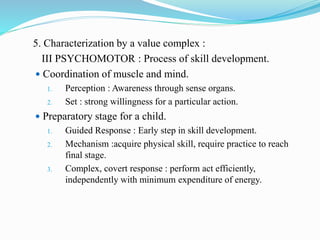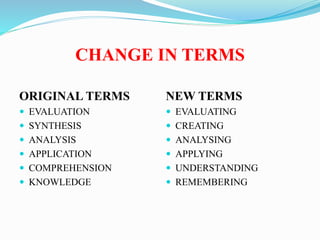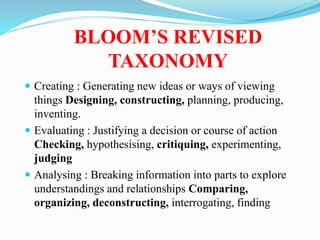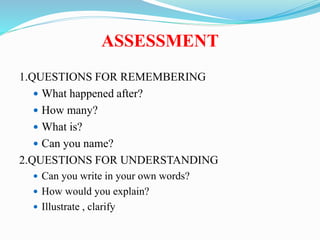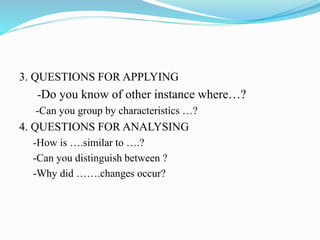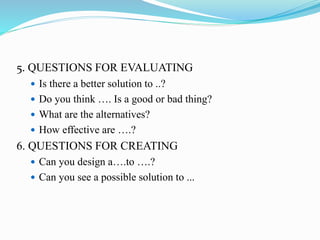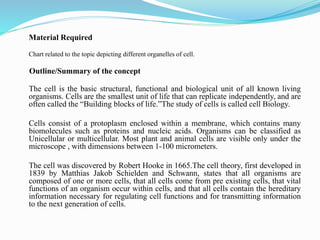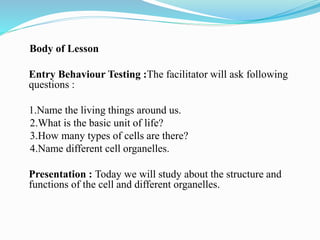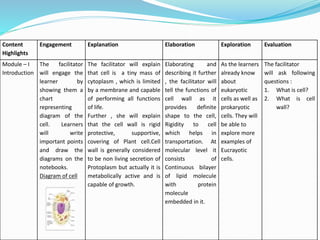Ppt ii blooms
- 1. Presentation by : Mandeep Kaur Enroll.No. 13/165 Pre Ph.D. Course work 6th Batch
- 2. BLOOMS TAXONOMY OF EDUCATIONAL OBJECTIVES  Dr. Benjamin S. Bloom – University of Chicago.  Taxonomy of Cognitive objectives in 1950.  Means of expressing qualitatively different types of thinking.  Been adapted for classroom use as a planning tool.  Divided education into 3 domains namely: a. Cognitive (Intellectual) b. Affective (Psychological) c. Psychomotor (Mascular)
- 3. COGNITIVE ď‚— Dealing with recall and recognition of knowledge, Development of intellectual abilities. ď‚— Educational objectives are organised under 6 main classes: 1. Knowledge 4. Analysis 2. Comprehension 5. Synthesis 3. Application 6. Evaluation
- 4. ď‚— Classes 1-3 deals with pupils ability to use subject matter in solution of problem without mentioning how solution is arrived at. ď‚— Classes 4-6 require both the ability to use concepts in solving problems and understanding Problem Solving Process. 1.Knowledge : Recall facts , methods , principles ď‚— Indicates zero level of understanding 2.Understanding : Ability to grasp, Interpret, extrapolate ď‚— Indicates first level of understanding 3.Application : ability to use comprehended material in new and concrete situations.
- 5. 4. Analysis : Ability to break material in to its parts to understand the organizational principles. ď‚— Indicates what students can do?(formulate hypotheses , illustrate relationships) ď‚— Represents higher intellectual level. 5. Synthesis : Put parts together, form combined whole. ď‚— Imagination, critical thinking required. ď‚— Ex. : Formulation of Research Proposal, Writing an essay.
- 6. 6. Evaluation : evaluate an idea, purpose, method in relation to certain criteria. II. AFFECTIVE : Internalization process. 1. Receiving : students willingness to attend a particular phenomena, stimulus. ď‚— Getting, holding , directing students attention. ď‚— Learning outcome : simple awareness to selective attention. ď‚— Lowest level of learning
- 7. 2. Responding : Active participation on part of students. - Learning outcome : information he gets through his own experience. 3. Valuing : Worth or value, student get attached to a particular process, phenomena. - Expressed in overt behavior. 4. Organization: Bringing together different values, resolving conflicts. - Comparing, relating, synthesizing values.
- 8. 5. Characterization by a value complex : III PSYCHOMOTOR : Process of skill development. ď‚— Coordination of muscle and mind. 1. Perception : Awareness through sense organs. 2. Set : strong willingness for a particular action. ď‚— Preparatory stage for a child. 1. Guided Response : Early step in skill development. 2. Mechanism :acquire physical skill, require practice to reach final stage. 3. Complex, covert response : perform act efficiently, independently with minimum expenditure of energy.
- 9. REVISED BLOOM’S TAXONOMY  In 1990s - LORIN ANDERSON (former student of Bloom) revisited the taxonomy.  Names of six main categories were changed from noun to verb.  Thinking is an active process verbs were used.  Categories are arranged from most basic to most complex thinking skills.
- 10. CHANGE IN TERMS ORIGINAL TERMS ď‚— EVALUATION ď‚— SYNTHESIS ď‚— ANALYSIS ď‚— APPLICATION ď‚— COMPREHENSION ď‚— KNOWLEDGE NEW TERMS ď‚— EVALUATING ď‚— CREATING ď‚— ANALYSING ď‚— APPLYING ď‚— UNDERSTANDING ď‚— REMEMBERING
- 11. BLOOM’S REVISED TAXONOMY  Creating : Generating new ideas or ways of viewing things Designing, constructing, planning, producing, inventing.  Evaluating : Justifying a decision or course of action Checking, hypothesising, critiquing, experimenting, judging  Analysing : Breaking information into parts to explore understandings and relationships Comparing, organizing, deconstructing, interrogating, finding
- 12. ď‚— Applying : Using information in another familiar situation Implementing, carrying out, using, executing ď‚— Understanding :Explaining ideas or concepts Interpreting, summarising, paraphrasing, classifying, explaining ď‚— Remembering : Recalling information Recognizing, listing, describing, retrieving, naming, finding
- 13. ASSESSMENT 1.QUESTIONS FOR REMEMBERING ď‚— What happened after? ď‚— How many? ď‚— What is? ď‚— Can you name? 2.QUESTIONS FOR UNDERSTANDING ď‚— Can you write in your own words? ď‚— How would you explain? ď‚— Illustrate , clarify
- 14. 3. QUESTIONS FOR APPLYING -Do you know of other instance where…? -Can you group by characteristics …? 4. QUESTIONS FOR ANALYSING -How is ….similar to ….? -Can you distinguish between ? -Why did …….changes occur?
- 15. 5. QUESTIONS FOR EVALUATING  Is there a better solution to ..?  Do you think …. Is a good or bad thing?  What are the alternatives?  How effective are ….? 6. QUESTIONS FOR CREATING  Can you design a….to ….?  Can you see a possible solution to ...
- 16. LESSON PLAN Facilitator’s Roll no.: 01 Date : 1/06/2014 Subject : Science Grade :IX Topic : The Cell Duration : 40 min Composition of Classroom Total number of learners : 25 Learners Linguistic Background : English, Hindi ,Punjabi Expected Cognitive Behaviour Outcome Enable the learners to : Remember : Define the organelles of the cell. Understand : Comprehend the different functions of the organelles of the cell. Apply : Use the concept of structure of cell and different functions of the cell in their daily life. Analyze : Examine the different organelles of cell. Evaluate : Justify the functions of different organelles of cell. Create/Problem Solving : Draw the diagram of the cell.
- 17. Material Required Chart related to the topic depicting different organelles of cell. Outline/Summary of the concept The cell is the basic structural, functional and biological unit of all known living organisms. Cells are the smallest unit of life that can replicate independently, and are often called the “Building blocks of life.”The study of cells is called cell Biology. Cells consist of a protoplasm enclosed within a membrane, which contains many biomolecules such as proteins and nucleic acids. Organisms can be classified as Unicellular or multicellular. Most plant and animal cells are visible only under the microscope , with dimensions between 1-100 micrometers. The cell was discovered by Robert Hooke in 1665.The cell theory, first developed in 1839 by Matthias Jakob Schielden and Schwann, states that all organisms are composed of one or more cells, that all cells come from pre existing cells, that vital functions of an organism occur within cells, and that all cells contain the hereditary information necessary for regulating cell functions and for transmitting information to the next generation of cells.
- 18. Methodology to be used Brain storming, discussion and Lecture cum Demonstration method. Roles Teacher as a Facilitator :The facilitator will create learning environment in the class. She will use Lecture cum Demonstration method to explain the organelles of the cell. By showing well labeled chart of structure of cell, the facilitator will elaborate the functions of cell. Student as a learner : The learners will try to sustain the learning environment created by the facilitator. They will observe and draw the structure of cell in their note books from the chart. They will also try to recall different organelles of the cell.
- 19. Body of Lesson Entry Behaviour Testing :The facilitator will ask following questions : 1.Name the living things around us. 2.What is the basic unit of life? 3.How many types of cells are there? 4.Name different cell organelles. Presentation : Today we will study about the structure and functions of the cell and different organelles.
- 20. Content Highlights Engagement Explanation Elaboration Exploration Evaluation Module – I Introduction The facilitator will engage the learner by showing them a chart representing diagram of the cell. Learners will write important points and draw the diagrams on the notebooks. Diagram of cell The facilitator will explain that cell is a tiny mass of cytoplasm , which is limited by a membrane and capable of performing all functions of life. Further , she will explain that the cell wall is rigid protective, supportive, covering of Plant cell.Cell wall is generally considered to be non living secretion of Protoplasm but actually it is metabolically active and is capable of growth. Elaborating and describing it further , the facilitator will tell the functions of cell wall as it provides definite shape to the cell, Rigidity to cell which helps in transportation. At molecular level it consists of Continuous bilayer of lipid molecule with protein molecule embedded in it. As the learners already know about eukaryotic cells as well as prokaryotic cells. They will be able to explore more examples of Eucrayotic cells. The facilitator will ask following questions : 1. What is cell? 2. What is cell wall?
- 21. CLOSURE Generalization : The learners will be able to know about the structure of the cell : i.e. cell wall, cell membrane ,cytoplasm , nucleus and their functions. Terminal Behaviour Testing : 1.What is the function of cell? 2. How many unit membranes bound the nucleus? 3. Name different cell organelles. 4. What is cytoplasm? Creative Assignment Draw a well labeled diagram of cell and its organelles. Suggestive References
- 22. THANKS

